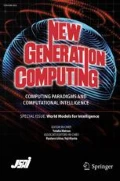Abstract
The increasing popularity and access to computer networks such as the Internet has introduced a new form of interaction among individuals, and brought about the social dimension to intelligent systems that are embedded into group and community settings. Knowledge is now seen as an asset not only of an individual but also of groups; research fields such as organisational memory, knowledge management and community ware are beginning to emerge. This paper surveys recent approaches, discusses whether social knowledge is a tangible notion, and examines the role of social knowledge in the context of group and community oriented systems with new challenges it offers.
Similar content being viewed by others
References
Ackerman, M. and McDonald, D., “Answer Garden 2: Merging Organisational Memory with Collaborative Help,” inProc. CSCW’96, pp. 97–105, 1996.
Benjamins, V. R. and Fensel, D., “Community is Knowledge! in (KA)2,” inProc. 11th Banff Knowledge Acquisition for Knowledge-Based System Workshop (KAW98), Banff, 1998.
Bowker, G. C., “Lest We Remember: Organisational Forgetting and the Production of Knowledge, http://alexia.lis.uiuc.edu/~bowker/forget.html
Buckingham Shum, S. “Negotiating the Construction and Reconstruction of Organisational Memories,”J. of Univ. Computer Science, 3, pp. 899–928, 1997.
Connerton, P.,How Societies Remember, Cambridge University Press, Cambridge, England, 1989.
Domingue, J., “Tadzebao and WebOnto: Discussing, Browsing, and Editing Ontologies on the Web,” inProc. 11th Knowledge Acquisition for Knowledge-Based Systems Workshop, Banff, 1998.
Donath, J. and Robertson, N., “The Sociable Web,” inProc. 2nd International Word Wide Web Conference, 1994.
Farquhar, A., Fikes, R., Pratt, W. and Rice, J. “Collaborative Ontology Construction for Information Integration,”KSL-95-63, Stanford Knowledge Systems Laboratory, 1995.
Farquhar, A., Fikes, R. and Rice, J., “The Ontolingua Server: A Tool for Collaborative Ontology Construction,”KSL-96-26, Stanford Knowledge Systems Laboratory, 1996.
Fensel, D., Decker, S., Erdmann, M. and Studer, R., “Ontobroker: The Very High Idea,” inProc. 11th International FLAIRS Conference (FLAIRS-98), Sanibal Island, Florida, 1998.
Garland, A. and Alterman, R., “Multiagent Learning through Collective Memory,” inProc. 1996 AAAI Spring Symposium on Adaptation, Co-evolution and Learning in Multiagent Systems, Stanford, 1996.
Gordon, T. F. and Karacapilidis, N., “The Zeno Argumentation Framework,” inProc. International Conference on Artificial Intelligence and Law (ICAIL-97), Melbourne, 1997.
GMD-FIT.CSCW,The Social Web Research Program, URL: http://orgwis.gmd.de/projects/SocialWeb 1998.
Gruber, T., “Toward Principles for the Design of Ontologies Used for Knowledge Sharing,”KSL-93-04, Stanford Knowledge Systems Laboratory, 1993.
Heylighen, F., Joslyn, C. and Turchin, V. eds.,Principia Cybernetica Web, URL: http://pespmc1.vub.ac.be created 1993.
Hewitt, C., “Viewing Control Structures as Patterns of Passing Messages,”Artif. Intell. 8, pp. 323–364, 1977.
Ishida, T., ed.,Community Computing: Collaboration over Global Information Networks, John Wiley & Sons, Chichester, 1998.
Kautz, H., Selman, B. and Shah, M., “The Hidden Web,”AI Magazine, pp. 27–36, Summer 1997.
Kunda, Z. and Thagard, P., “Forming Impressions from Stereotypes, Traits, and Behaviours,”Psychological Review, 103, pp. 283–308, 1996.
Lacey, N., Nakata, K. and Lee, M., “Investigating the Effects of Explicit Epistemology on a Distributed Learning System,” inDistributed Artificial Intelligence Meets Machine Learning (Weiss, G. ed.),Lecture Notes in Artificial Intelligence, 1221, pp. 276–292, Springer-Verlag, 1997.
Lenat, D. B., “CYC: A Large-Scale Investment in Knowledge Infrastructure,”Communications of the ACM 38, 11, pp. 33–38, Nov. 1995.
Levesque, H. J. and Brachman, R. J., “A Fundamanetal Tradeoff in Knowledge Representation and Reasoning (revised version),” inReadings in Knowledge Representation (Brachman, R. J. and Levesque, H. J. eds.), pp. 41–70, Morgan Kaufmann, Los Altos, 1985.
Marshall, C. C., Shipman, F. M. III and McCall, R. J., “Making Large-Scale Information Resources Serve Communities of Practice,”J. of Management Information Systems 11, 4, pp. 65–86, 1995.
Mamdani, A., Pitt, J. and Stathis, K., “Connected Communities from the standpoint of Multi-agent Systems,”New Gener. Comput., 17, 4, 1999.
Nakata, K., Voss, A., Juhnke, M. and Kreifelts, T., “Concept Index: Capturing Emergent Community Knowledge from Documents,” inThe 7th Le Travail Humain Workshop “Designing Collective Memories” (Marti, P. and Bagnara, S. eds.), Paris, 1998.
Nakata, K., Voss, A., Juhnke, M. and Kreifelts, T., “Collaborative Concept Extraction and Management,” inProc. of the 2nd Int. Conf. on Practical Aspects of Knowledge Management (PAKM98) (Reimer, U. ed.), Basel, 1998.
Nishida, T., Hirata, T. and Maeda, H., “CoMeMo-Community: a System for Supporting Community Knowledge Evolution,” inProc. of the First Kyoto Meeting on Social Interaction and Communityware, Kyoto, Japan, 1998.
Nonaka, I. and Takeuchi, H.,The Knowledge-Creating Company, Oxford University Press, Oxford, 1995.
Quine, W. V. O.,Word and Object, John Wiley & Sons, New York, 1960.
Rich, E., “User Modeling via Stereotypes,”Cognitive Science, 3, pp. 329–354, 1979.
Rinaldi, G. R. and Padula, M., “Designing Virtual Social Memory Organizers: Online and Offline Perspectives for Historical Earthquake Data Organization and Dissemination,” inProc. INET’96, Montreal, 1996.
Rogers, Y. and Ellis, J., “Distributed Cognition: an Alternative Framework for Analysing and Explaining Collaborative Working,”J. of Information Technology, 9, 2, pp. 119–128, 1994.
Stefik, M., “The Next Knowledge Medium,”The AI Magazine, 7, 1, pp. 34–46, Spring 1986.
Thagard, P. and Verbeurgt, K., “Coherence as Constraint Satisfaction,”Cognitive Science, 22, pp. 1–24, 1998.
Yates, F.,The Art of Memory, University of Chicago Press, Chicago, 1966.
Author information
Authors and Affiliations
Additional information
Keiichi Nakata, Ph.D.: He is a research scientist at the Institute for Applied Information Technology (FIT) at GMD. He is currently a member of the “Social Web” research programme at GMD, with a particular interest in the investigation of social development of knowledge that belongs to communities, and its application to support social interactions. Prior to the current appointment, he has held lectureships at the University of Wales and Oxford Brookes University in UK. His academic background is BEng and MEng degrees in nuclear engineering from the University of Tokyo and PhD in AI from the University of Edinburgh.
About this article
Cite this article
Nakata, K. Knowledge as a Social Medium. NGCO 17, 395–405 (1999). https://doi.org/10.1007/BF03037245
Received:
Revised:
Issue Date:
DOI: https://doi.org/10.1007/BF03037245




